January 30 Scots Book of Days
January 30 – 1325 Margaret de Menteith daughter of Alexander Earl of Menteith. Wife of Alexander de Abernethy, She resided in England as late as 30 Jan 1325, when a record in the Patent Rolls dated at Langley stated, ‘1360. The K. signifies that he has granted leave to Margaret de Abernethy to visit Scotland, to treat with her friends there as to recovery of her hereditary lands. Langley.
Abernethy Crest: A raven Sable, beaked and membered Gules
Motto: SALUS PER CHRISTUM [from Latin: Salvation through Christ] Seat: Abernethy, Perth and Kinross
1532 sometime this year. A royal charter was granted to University of Saint Andrews after Papal authority in 1410, when James Kennedy was Bishop of St Andrews and founder of Scotland’s first university. (clan Kennedy)
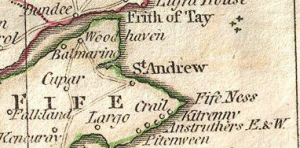 1799 map with St Andrew on the coast of Fife, with Falkland, Largo, Pitenween, Anstruthers E & W, Kitrenny, Crail, Fife Ness, Cupar, Balmarino, Woodhaven, Frith of Tay, Dundee.
1799 map with St Andrew on the coast of Fife, with Falkland, Largo, Pitenween, Anstruthers E & W, Kitrenny, Crail, Fife Ness, Cupar, Balmarino, Woodhaven, Frith of Tay, Dundee.
1540 sometime in January. James V King of Scots ordered the Edinburgh goldsmith John Mosman to refashion the Crown of Scotland.
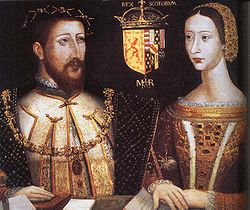 Mary of Guise and her second husband, King James V of Scotland. Mary was widow of Louis II Duke of Longueville who died 1537. James was the widower of Madeleine of Valois who also died in 1537. Mary will become the ancestress of all Scots royalty after 1542 (as mother of Mary Queen of Scots) and English from 1603 (as Grandmother of James 1st of England). The reformed crown was first worn by James V to the coronation of his second wife, Mary of Guise, as queen consort at Holyrood Abbey, Edinburgh.
Mary of Guise and her second husband, King James V of Scotland. Mary was widow of Louis II Duke of Longueville who died 1537. James was the widower of Madeleine of Valois who also died in 1537. Mary will become the ancestress of all Scots royalty after 1542 (as mother of Mary Queen of Scots) and English from 1603 (as Grandmother of James 1st of England). The reformed crown was first worn by James V to the coronation of his second wife, Mary of Guise, as queen consort at Holyrood Abbey, Edinburgh.
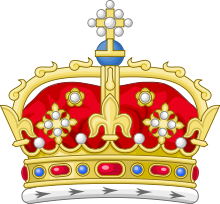 January 1540, King James V commissioned the royal goldsmith, John Mosman, to refashion the Crown of Scotland. The existing crown was delicate and had been repaired at least twice in the previous 30 years, and a 1539 inventory showed further damage, including the loss of one fleur-de-lis. Mosman dismantled the old crown and removed its stones and pearls. The crown was melted down and Mosman added 41 ounces of gold mined at Crawford Moor in Lanarkshire.
January 1540, King James V commissioned the royal goldsmith, John Mosman, to refashion the Crown of Scotland. The existing crown was delicate and had been repaired at least twice in the previous 30 years, and a 1539 inventory showed further damage, including the loss of one fleur-de-lis. Mosman dismantled the old crown and removed its stones and pearls. The crown was melted down and Mosman added 41 ounces of gold mined at Crawford Moor in Lanarkshire.
Constructed of solid gold, the crown consists of a base, with four fleur-de-lis alternating with four strawberry leaves. The four arches of the crown are decorated with gold and red oak leaves. At the intersection of the arches is a golden monde, painted blue with gold stars. The monde is surmounted by a large cross decorated in gold and black enamel and pearls. The crown is encrusted with 22 gemstones, including garnets and amethysts, 20 precious stones and 68 Scottish freshwater pearls.
The Honours of Scotland crown escaped destruction during the Civil War (1640-1660), hiding out in Kincardinseshire, whereas the English crown did not. Wikipedia.
1542 – sometime this year. Battle of Alltan-Beath Scottish clan battle said to have taken place in the year 1542 in the village of Knockartel, in the Scottish Highlands. It was fought between men of the Clan MacKay, Clan Sutherland and Clan Murray.
1547 sometime this year. 5,000 English who overran Dumfriesshire, sacking the Clan Jardine lands and forcing John Jardine of Applegirth to yield.
1556 sometime this year. William Cochrane, chief of Clan Cochrane obtained a charter of confirmation for the lands of Cochrane, Renfrewshire, Scotland, from Mary, Queen of Scots. Just of ahead of the Reformation in Scotland. (William’s grandson became Earl of Dundonald, and in turn was an ancestor of Princess Diana Spencer.)
1560 sometime this year. With the Scottish Reformation in 1560 monasticism in Scotland was stopped, within months.
1592 sometime this year. The Clan MacKintosh sacked Auchindoun Castle which belonged to the Clan Cochrane.
1599 never happened in Scotland. There was no January 1st 1599 to March 24th of the year 1599 in Scotland. New Year’s Day began from 1600. The Scottish year 1599 was 10 months from March 25th to December 31st. Scotland and England kept different calendars (at least from January to March 24) for the next century and a half For the previous 15 centuries, from the time of Julius Ceasar, the new year began with the Spring Equinox, or March 25th, called Lady day in England. Hence September was the 7th month from March, from the Latin Septiem for seven. October the 8th month from the Latin octo for eight, November the 9th month from the Latin Novem for nine. And December from the Latin Decem for 10, or the 10th month of the year. . From 1155 to 1751 England and its colonies New Year began on 25 March and begin January 1 as start of year in 1752.
1606 sometime this year. The once grand title ‘Prior of Coldingham’ were held by the sixth Lord Home. Home gave up this spirituality, and the Scottish Parliament confirmed it.
1645 sometime this year. Alexander Jardine, in 1645, created a Baronet of Nova Scotia. Son of Sir Alexander Jardine through marriage to Lady Margaret Douglas, sister of the first Duke of Queensberry, Clan Douglas.
 Douglas Motto: JAMAIS ARRIÈRE.
[from French: “Never behind”]. The Douglas-Hamiltons are heirs to the chiefship, however the Lord Lyon requires them to assume the single name Douglas for them to be granted the title of chief. Crest: On a chapeau Gules furred Ermine, a salamander Vert encircled with flames of fire Proper.
Douglas Motto: JAMAIS ARRIÈRE.
[from French: “Never behind”]. The Douglas-Hamiltons are heirs to the chiefship, however the Lord Lyon requires them to assume the single name Douglas for them to be granted the title of chief. Crest: On a chapeau Gules furred Ermine, a salamander Vert encircled with flames of fire Proper.
Douglas 1036 2Stewart 2Ruthven 2Kinchin 2Jared 2Simmons 2Choate – Douglas 2Montgomberie 2Blair 2Cochrane 2Miller 2Simmons 2Choate – Douglas 2Hamilton 2Stewart 2Miller 2Simmons 2Choate – Douglas 2Carlyle 2Semple 2Montgomery 2Cochrane 2Miller 2Simmons 2Choate
1648 Peace of Münster between the Dutch Republic and the Kingdom of Spain on 30 January 1648, officially ratified in Münster on 15 May 1648.
Ratification of the Peace of Münster (Gerard ter Borch, Münster, 1648)
1649 [Edinburgh year] 1648 [London year]– (both the same day in different years). King Charles I of England and King of Scots beheaded at Palace of Whitehall. TG 45-68 the Rump Parliament passes Act prohibiting the proclaiming any person to be King of England or Ireland, or the Dominions thereof.
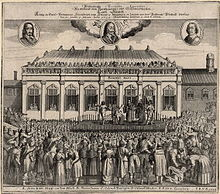 This contemporary German print depicts Charles I’s decapitation. Charles, King and Martyr, 1649. Charles was 49 years old, in the 24th year of his reign. Tytler’s Britannica.
This contemporary German print depicts Charles I’s decapitation. Charles, King and Martyr, 1649. Charles was 49 years old, in the 24th year of his reign. Tytler’s Britannica.
Charles I is executed – 1649. After refusing to recognise the legitimacy of the court during his trial, Charles is found guilty of treason and executed. In Scotland his son is declared Charles II, King of Scots. Video: A history of Scotland: God’s Chosen People.
http://www.bbc.co.uk/scotland/history/covenanters/charles_i_executed/
1650 sometime this year. After Cromwell’s success at Dunbar against the Scots in 1650, Cromwell came across some royalists occupying the auld buildings of Coldingham Priory, Berwickshire, Scotland. Cromwell used his canon to oust the royalists and left only two walls standing. These were two walls of the quire of Thomas’ church. Shortly after they were incorporated in a new structure.
1660 – King Charles II of England, King of Scots since 1650.
Charles II becomes King after Cromwell’s death – 1660, After the death of Cromwell, the Protectorate regime collapses and amid wild popular jubilation Charles II is confirmed as King of England, Ireland and Scotland. Rumoured to be a Catholic, Charles supports the Anglican policies of his father. Video: The Sword and the Cross: Covenant or King.
http://www.bbc.co.uk/scotland/history/covenanters/charles_ii_becomes_king_after_cromwells_death/
1669 sometime this year. Earl of Dundonald created for William Cochrane, Lord Cochrane, and brother of Colonel Hugh Cochrane.
1716 – Highlanders leave Perth. (TG 73-420)
1746 Duke of Cumberland, the King’s son, reached Edinburgh with 14,000 troops. Cumberland heads toward Stirling, and the Highlanders’ raise the siege and retreat to the Highlands. Tytler’s Britannica. The story also becomes a subplot in Henry Fielding’s fictional Tom Jones.
Preparations made for the retreat.
1751 did not occur in England, Ireland, British North America, and British colonies, as 1751 only had 282 days due to the Calendar Act of 1750. As a result of the Act, Scotland adopted the Gregorian calendar in 1752. From 1753 until 1799, the tax year began on 5 April, which corresponded to 25 March Old Style.
1766 William Cochrane died 20.01.1766, Judge Advocate.
1789 COLDINGHAM PRIORY sketch. Berwickshire, Scotland.
1825 Sir Henry Jardine, died, being born in Edinburgh, 30th January 1766, was knighted in 1825 and later made a Fellow of the Royal Society of Edinburgh.
1830 Scots Roman Type, prepared in Glasgow Scotland, and shipped to a foundry in Albany New York, then delivered to the E. B. Grandin Printing company in Palmyra New York, according to the Crandall Gutenberg Printing Museum in Provo Utah. The Scots Roman type is the font used to print the first edition of the Book of Mormon. The contract with E. B. Grandin’s print shop to print the book was signed on Tuesday 25 Aug 1829, and the completed book was on sale by Friday 26 March 1830. Typesetter John H. Gilbert selects type and inserts commas, periods, and other punctuation as Gilbert reads Oliver Cowdery’s hand written copy. One form signature of 16 pages, in quantities of 5,000 copies will be printed, 37 signatures, a form per 6 day, 11 hour per day week. Meridian Magazine (14 Apr 2005). http://www.johnpratt.com/items/docs/lds/meridian/2005/printing.html
22nd form of 16 pages printed. Somewhere in Alma.
- Replica Printing press
Replica copies (circa 2012) of the Book of Mormon (originally released 1830)
1840 Mulliner continued to preach in this area until the end of the month, at which time he left for Edinburgh, where Elder Wright had asked him to meet and join in the work. Here they preached for a two weeks before returning to Bishopton. They then began to proselytize in various towns in this region, including the towns of Paisley, Johnstone, Houston, Bridge-of-Weir, and Kilpatrick. At Paisley they hired a hall and began to preach at public meetings. In Kilpatrick, they encountered opposition. A mob forced them to leave town, pelting them with rubbish and stones. Some ten thousand Scots converted to Mormonism, and about half (five thousand) responded to the call to gather to Zion. Members of The Church of Jesus Christ of Latter-day Saints.
Houston counties – Alabama, Georgia, Minnesota, Tennessee, Texas
1924 January 30. Winter Olympics preceding the Summer Olympics in June. David George Brownlow Cecil, 6th Marquess of Exeter KCMG (9 February 1905 – 22 October 1981), styled Lord Burghley before 1956 and also known as David Burghley. David Burghley made the British team for the 1924 Olympics, but was eliminated before the medal round. Burghley won gold in the 110 meter hurdles at the 1928 summer Olympics. Burghley served as Rector of the University of Saint Andrews 1949 to 1952. Lord Burghley married firstly in 1929, Lady Mary Theresa Montagu Douglas Scott (4 March 1904 – 1 June 1984), fourth daughter of Sir John Montagu Douglas Scott, 7th Duke of Buccleuch & 9th Duke of Queensberry and Lady Margaret Alice “Molly” Bridgeman’. 1923 – September 28 – John Scott, born, 9th Duke of Buccleuch, British politician Walter Francis John Montagu Douglas Scott, 9th Duke of Buccleuch and 11th Duke of Queensberry, KT Knight Order of the Thistle, VRD, Volunteer Reserve Decoration, JP, Justice of the Peace, DL Deputy Lieutenant, (28 September 1923 – 4 September 2007) was a Scottish Peer, politician and landowner.
Disclaimer:
Utah Standard News depends on the support of readers like you.
Good Journalism requires time, expertise, passion and money. We know you appreciate the coverage here. Please help us to continue as an alternative news website by becoming a subscriber or making a donation. To learn more about our subscription options or make a donation, click here.
To Advertise on UtahStandardNews.com, please contact us at: ed@utahstandardnews.com.


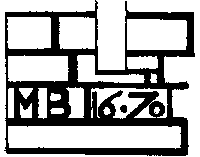
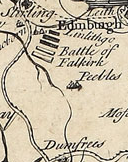
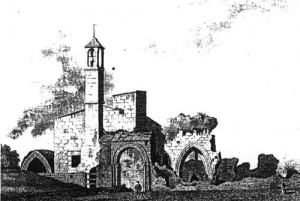
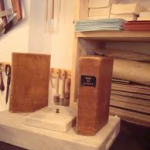
Comments - No Responses to “January 30 Scots Book of Days”
Sure is empty down here...